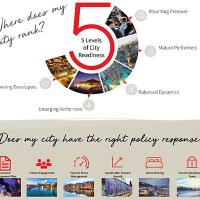[ad_1]
CHICAGO and SEVILLE – Determining a city’s future readiness for tourism growth requires a holistic view that accounts not only for its current physical and natural assets, but also for its social capital and the impact of its policies. Whether a city is looking to grow its Travel & Tourism sector or manage rising visitor numbers, business and city leaders must balance all the dynamics that make up a city’s fabric.
Findings from the World Travel & Tourism Council (WTTC) and JLL’s comprehensive index, Destination 2030: Global cities’ readiness for tourism growth (“Destination 2030”), address the question of what makes a city ready for Travel & Tourism growth at the WTTC Global Summit in Seville, Spain. Destination 2030 measures and categorizes 50 global gateway cities into one of five levels of “readiness” and provides actionable solutions to foster sustainable growth in tourism activity.
“In today’s competitive environment, a holistic understanding of markets and indicators is more important than ever in shaping global investment strategy,” said JLL Global Hotels CEO Mark Wynne-Smith. “Cities with a comprehensive approach to Travel & Tourism to ensure they are prepared for future growth are increasingly appealing from an investment standpoint.”
The levels range from emerging to established market tourism hubs with varying levels of infrastructure. They also describe the current opportunities and challenges faced by the cities and provide a recommended path forward for building and maintaining tourism activity:
- Dawning Developers are cities with an emerging tourism infrastructure, slower tourism growth and lower visitor concentration but have room to grow. Examples include Manila, Moscow and Riyadh.
- Emerging Performers are cities with an emerging tourism infrastructure, growing tourism momentum and the start of increasing pressures related to tourism growth. Examples include Delhi, Istanbul and Mexico City.
- Balanced Dynamics are cities that are often financial hubs, with lower shares of leisure, compared to business travel but an established tourism infrastructure and potential for Travel & Tourism growth. Examples include Chicago, Munich and Tokyo.
- Mature Performers are cities with strong leisure and/or business travel dynamics and an established tourism infrastructure, but risk of future strains related to visitor volume, infrastructure or activity that is testing readiness for additional growth. Examples include Berlin, London and Sydney.
- Mounting Pressure are cities with high growth momentum driven by leisure travel and established tourism infrastructure. However, these cities face pressures to manage high visitor volumes. Examples include Amsterdam, Barcelona and Prague.
“Travel & Tourism can play a significant role in a city’s economy, boosting GDP and creating jobs,” said WTTC President & CEO, Gloria Guevara. “Managed well, a strong visitor economy can also help a destination to thrive, by bringing connectivity, fostering diversity, engendering hospitality and by creating a real sense of place for all who live, work and visit the city. With this novel framework, city planning authorities and legislators, investors and real estate developers, tourism organizations and Travel & Tourism companies can evaluate global cities’ readiness for future expected tourism volumes by 2030.”
The readiness levels were determined by analyzing data on more than 70 indicators. These included the size and density of each city’s current Travel & Tourism market, a wide range of leisure and business drivers, ‘urban readiness’ characteristics such as labor availability, urban infrastructure, environmental factors and stability, and city-level tourism policies.
“The pace of change is faster every year and requires an assessment of all components that make up a city’s character,” said JLL Director of Global Hotels Research Lauro Ferroni. “Growth is not only organic – by implementing investment-friendly policies, cities can increase or maintain visitor volume and attract investment activity.”
[ad_2]You can read more of the news on source
 Travelsmart
Travelsmart



